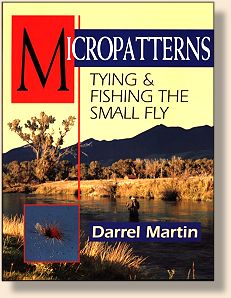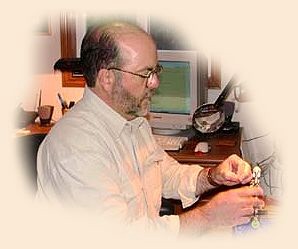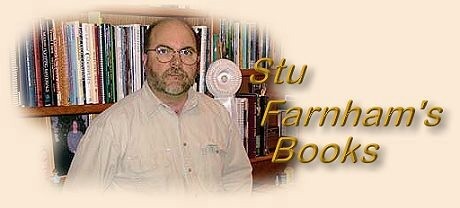|
The Internet is a powerful resource. It provides us instant
access to information, and brings us together via email,
bulletin boards, chat rooms, and instant messaging. FAOL
is a wonderful example of the Internet at its best. The Internet,
however, will never replace the printed page.
I've loved books and fishing since my youngest years, although
I did not start fly fishing until 1993. This column will give
me an opportunity to share reviews of some of my favorite fly
fishing and tying books (and some that are not such favorites)
with my friends here at FAOL. My library reflects my tastes
and interests, and so will this column. It will be heavily
slanted towards cold water fishing and tying for trout and
steelhead, and won't touch much on areas of which I know little,
such as warm or salt water fishing.
I hope that these reviews will motivate some of you to pick up
a good book, on this or any subject, and read.
~ Stu Farnham
Micropatterns: Tying and Fishing the Small Fly
 Micropatterns: Tying and Fishing the Small Fly
Micropatterns: Tying and Fishing the Small Fly
Darrel Martin
Paperback - 352 pages, 1st edition (March 1, 1999)
Dimensions (in inches): 1.22 x 10.97 x 8.47
The Lyons Press
ISBN: 1558218947
Increased selectivity of trout and the corresponding increase
in hatch matching has led to the tying and fishing of
increasingly small patterns. Where attractor patterns in
sizes 10 and 12 once filled most of my fly boxes, it is
rare now for me to tie larger than a size 16 (except for
March Browns, Green Drakes, October Caddis, and giant
stoneflies).
Darrel Martin, a regular contributor to Fly Rod & Reel
magazine, produced the first (only?) book to address tying
and fishing small flies, his Micropatterns. Originally released
in hardbound in 1994, this book was out of print for several
years until The Lyons Press issued a paperback edition in 1999.
Martin defines micropatterns as those tied in sizes 18 and
smaller, based on his observation that there is a division
in difficulty between sizes 16 and 18. It is at size 18 that
the problems of tying in the small manifest themselves. He
opens the books (following a foreword by John Goddard, a
preface by Ted Leeson, and Martin's own wonderful introduction)
with a chapter on the insects typically imitated by micropatterns:
pseudocloeons, caenis, tricos, microcaddis, pale morning duns,
and others. Large, detailed ink drawings accompany the text,
and a helpful section on field identification is included.
The chapter on tools is mostly devoted to basics, with two
exceptions: the discussion of vises talks of the use of a rotary
vise to position your fly to provide the best access to and
view of the fly throughout the tying process. He also touches
on a subject dear to my own middle aged heart and eyes, the
importance of good lighting to good tying. My own setup
includes a swing-arm, 150watt halogen lamp, light blue extruded
foam board as a backdrop, and a dull gray surface on my tying
desk. I use a Giraffe magnifier and an Opt visor when I need
magnification.
There's a helpful and detailed chapter on materials, emphasizing
natural materials and their application to micropatterns. This
chapter includes a good discussion of CDC feathers.
The parts of this book to which I return repeatedly are the chapters
on methods and patterns. Thread control, building extended bodies,
use of beads in small flies, methods for using and managing CDC,
dubbing, and several winging methods are covered. The emphasis
in the chapter on fly patterns is on the work of European tiers;
being from the US Pacific Northwest, I found these patterns a
refreshing change from standard North American fare.
The chapter on tackle is dominated by a discussion of the use and
making of furled leaders. I'm just trying out some of these in my
own fishing, made by Jim Cramer of California. There's also a
short section on knots.
The last chapters deal with the issues of fishing small patterns
over selective trout. A diagram of a prototypical stream shows
the types of water in which the various micro-species occur.
The section on presentation talks about line control, which
I believe to be the single hardest issue for fly fishers to
understand and address. There's a good discussion of casting
techniques, line tactics, and downstream presentations.
Darrel is nothing if not attentive to detail, and this book
sometimes goes a bit far. One example is the discussion of
hooks. The basics are here: nomenclature, sizing charts from
Partridge and Mustard. There is also a detailed mechanical
analysis of the deformation and breaking characteristics of
hooks in general, and the observed characteristics of a number
of specific brands and models, presented in page after page
of graphs.
This discussion may be of interest to the mechanical engineers
among us, but goes beyond what the average - or even advanced - fly
fisher needs to know. I found the chapter on hook design in
Martin's 1987 Fly Tying Methods to be of greater practical
value to the fly fisher. Out of all this data, however, comes
a description of the ideal small fly hook. There's also an
appendix showing the cross-sectional mass of a number of
different fly lines at various points along their length
which is of passing interest but no particular long-term
value.
I would have preferred that the forty or so pages devoted to
such overly technical material had instead been filled instead
with more tying techniques and patterns. Notwithstanding this
minor complaint, Micropatterns, and Martin's out
of print Fly Tying Methods deserve shelf space
in the libraries of everyone who ties flies for trout.
~ Stu Farnham
About Stu
 Stu Farnham is a New Englander by birth, who was transplanted to
and put down roots in Oregon in the early 1990s. A software
engineering manager by vocation, he can be found in his spare
time chasing trout and steelhead in the rivers of the Pacific
Northwest, chasing his four Gordon Setters (who in turn are
chasing chukar), tying flies, reading, or working on his website.
Colleen, his long suffering wife of 28 years, is a professionally
trained personal chef.
Stu Farnham is a New Englander by birth, who was transplanted to
and put down roots in Oregon in the early 1990s. A software
engineering manager by vocation, he can be found in his spare
time chasing trout and steelhead in the rivers of the Pacific
Northwest, chasing his four Gordon Setters (who in turn are
chasing chukar), tying flies, reading, or working on his website.
Colleen, his long suffering wife of 28 years, is a professionally
trained personal chef.
|

 Micropatterns: Tying and Fishing the Small Fly
Micropatterns: Tying and Fishing the Small Fly Stu Farnham is a New Englander by birth, who was transplanted to
and put down roots in Oregon in the early 1990s. A software
engineering manager by vocation, he can be found in his spare
time chasing trout and steelhead in the rivers of the Pacific
Northwest, chasing his four Gordon Setters (who in turn are
chasing chukar), tying flies, reading, or working on his website.
Colleen, his long suffering wife of 28 years, is a professionally
trained personal chef.
Stu Farnham is a New Englander by birth, who was transplanted to
and put down roots in Oregon in the early 1990s. A software
engineering manager by vocation, he can be found in his spare
time chasing trout and steelhead in the rivers of the Pacific
Northwest, chasing his four Gordon Setters (who in turn are
chasing chukar), tying flies, reading, or working on his website.
Colleen, his long suffering wife of 28 years, is a professionally
trained personal chef.